![]()
![]()
![]()
Use LEFT and RIGHT arrow keys to navigate between flashcards;
Use UP and DOWN arrow keys to flip the card;
H to show hint;
A reads text to speech;
94 Cards in this Set
- Front
- Back
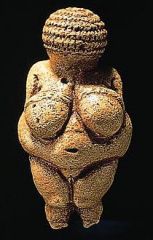
|
PALEOLITHIC ART Austria c. 24,000 BCE |
|
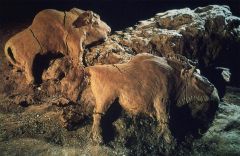
|
PALEOLITHIC ART BISON Le Tuc d'Audoubert, France c. 13,000 BCE |
|
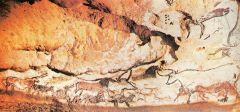
|
PALEOLITHIC ART Hall of Bulls Lascaux Cave, France c. 32,000 BCE found: 1940 -very colorful |
|
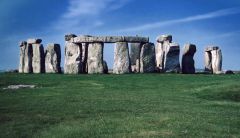
|
NEOLITHIC ART Stonehenge Salisbury, England c. 2900-1500 BCE
- Made of 30 Sarsen Stone (some from Wales) - Took over 1000 years to put together - Ritualistic purpose maybe - Location was chosen for a purpose |
|
|
Post and Lintel |
An Architectual system of construction with 2 or more vertical elements supporting a horizontal element. |
|
|
Wattle and Daub |
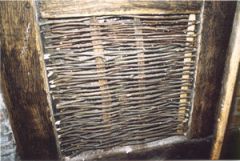
a wall construction method combining upright branches and twigs. |
|
|
Corbeling |
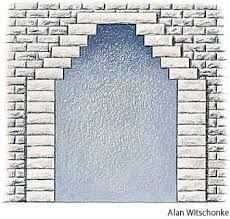
stones stacked for roofing. |
|
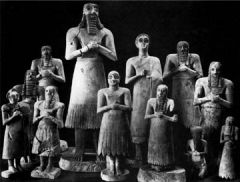
|
Summerian (Iraq) Votive Figures Square Temple, c. 2900 - 2600 BCE |
|

|
Sumerian Art Standard Of Ur c. 2600 BCE |
|
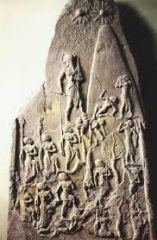
|
Akkadian Art Victory Stele of Naram Sin r. 2254-2218 BCE
-Naram Sin was a ruler - Depicts him closer to the Sun God and more important than others because of size |
|
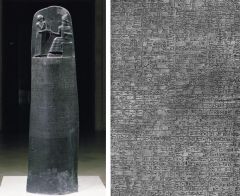
|
Babylonian Art Stele of Hammurabi c. 1780 BCE
- LAW OF CODES TOO - First written down Law System - "Eye for an eye" seen here. |
|

Assurnasirpal II Killing Lions |
Assyrian Art
- King shows dominance |
|
|
Cuneiform |
An early form of writing with wedge-shaped marks impressed into wet clay with a stylus.
- used by Mesopotamians |
|
|
Ziggurat |

Ancient Mesopotamia, tall stepped tower of earthen materials, often supporting a shrine |
|

|
Pre-dynastic Egyptian Art Palette of Narmer c. 2950
-makeup tray |
|
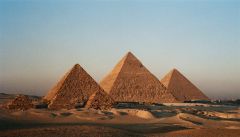
|
Old Kingdom (Ancient Egypt) Great Pyramids of Giza Pyramids of Khufu, Khafre and Menkaure c. 2520-2494 BCE
- 3 pharaohs buried here - 4th dynasty |
|
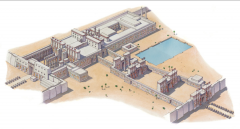
Reconstructed Drawing |

New Kingdom (ANCIENT EGYPT) Great Temple of Amun @ Karnak c. 1579-1075
- Hypostyle hall |
|
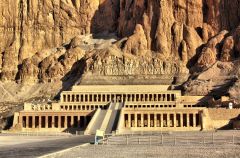
|
New Kingdom Temple of Hatshepsut c. 1473-58 BCE
- Female queen/leader - She claimed divine descent
|
|
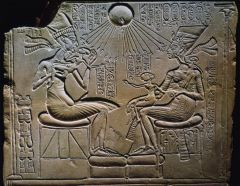
|
Amarna Period Akhenaten, Nefertiri & 3 Daughters c. 1353-36
- More curvy statues - Pharaoh changed religion from polytheistic to Monotheistic - ONE god = Ahten (sun god) - Claimed to be god's priest - Changed Capitol |
|

|
New Kingdom Innermost Coffin of King Tutankhamun c. 1332-1322
- Howard Carter found it in 1920 - Found in Valley of the Kings |
|
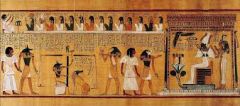
|
New Kingdom Last Judgement of Hu-Nefer Before Osiris 19th Dynasty c. 1285
- Hu-Nefer was a high ranking scribe. - Depicts all gods: Anubis, Tha, Horus, Osiris, Isis |
|
|
Mastaba |

|
|
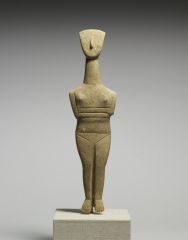
|
Cycladic Art Figure of a Woman c. 2600-2400 BCE
|
|
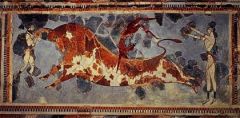
|
Minoan Art Bull-Leaping @ Palace at Knosses c. 1450
- Buon Fresco painting - Acrobatic woman and man in painting |
|
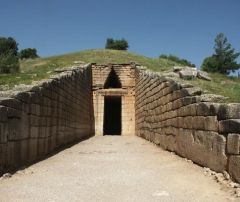
|
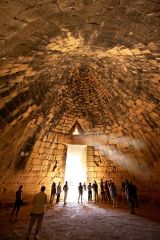
Mycenaean Art Tholos / "Treasury of Atreus" c. 1300-1200 BCE
- CORBEL VAULT - Arched in stones - Creates space |
|
|
Buon Fresco |
Painting on plaster WHILE it's wet. |
|
|
Fresco Secco |
Painting on plaster while it's dry |
|
|
Repousse |
Technique of hammering/pushing metal from the back to create an image on front. |
|
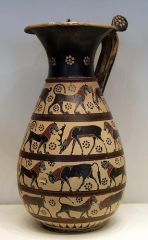
|
Orientalizing Style Olpe Pitcher c. 650-625 BCE
- Depicts lions and Panthers - More color - More curvy-REALISTIC - Still in registars |
|
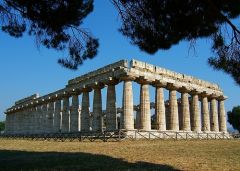
|
Archaic Art Temple of Hera 1 c.550 BCE Paestum, Italy
- More decoration on outside than inside - Doric Order/Columns |
|
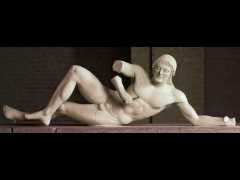
|
Archaic Art Dying Warrior of WEST Pediment c. 500-490 BCE
- At Temple of Aphaia -ARCHAIC SMILE= sign oof life - Soldier - No sign of old age - More Styalized
|
|
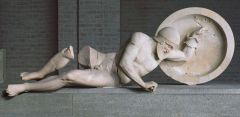
|
Archaic Art Dying Warrior of EAST Pediment c. 490-480 BCE
- At Temple of Aphaia - NO archaic smile - Beard - Has armory - Looks more naturalistic while dying - Shows more "feeling" |
|

|
Archaic Art Kouros c. 530 BCE
- Marble - Life-size - Young boy (ARCHAIC SMILE) |
|
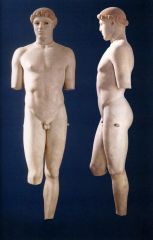
|
Early Classical Kritios Boy c. 480 BCE
- Marble - Contrapposto - Not trying to show life - More human-like
|
|

|
HIGH CLASSICAL Parthenon c. 447-438 BCE Athens, Greece
- Doric columns - Paristyle columns all around |
|
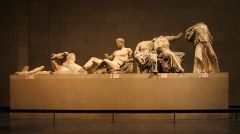
|
HIGH CLASSICAL Pediment Sculptures of Parthenon
- conflict because they are in British Museaum when belong in Athens, Greece - Shows more drapery - More dramatic |
|

|
HIGH CLASSICAL Polykleitos, Doryphoros (Spear Bearer) c. 450-440 BCE
- Original piece was in Bronze for Greeks - Romans made this Marble Copy - Musculature is a LOT better - Has stump for support |
|
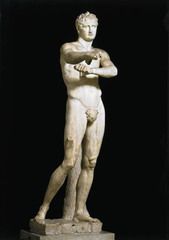
|
LATE CLASSICAL Apoxymenos (Scraper) artist: Lysippos c. 330 BCE
-Roman copy, original was bronze not marble - Has stump - Good Anatomy - Depicts NORMAL person instead of gods which is rare - LYSIPPOS CHANGED BODY ANATOMY to 8 heads |
|
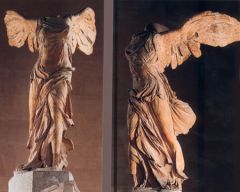
|
HELLENISTIC Nike (Victory) of Samothrace c. 180 BCE
- Missing head/arms/wings - full of emotion and motion - more drapery - MORE DRAMA |
|
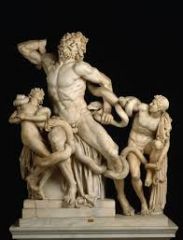
|
HELLENISTIC Laocoon and His Sons c. 1rst century
- Hagesandros, Polydoros, Athendoros of Rhodes - Roman copy= DRAMATIC STORY: Laocoon is a prophet and sees trojans are going to be taken over by Horse and want to warn them, but Poseidon send snakes to kill him and his sons. |
|
|
Terra Cotta |
a medium made from clay fired over a low heat and sometimes left unlglazed. |
|
|
Red Figure Vase Painting |
red colored figures on a black background. |
|
|
Black Figure Vase Painting |
black figures painted on red clay background. |
|
|
Contrapposto |
human figures with opposing alternations of tensions; shows sense of movement. |
|

|
Doric- Oldest; Most simple; Masculine form Ionic- More feminine; Skinnier; Taller; Elegant Corinthian- Leaf-like shapes in capitol; Most complex |
|
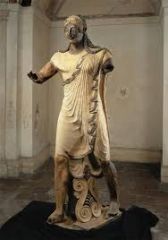
|
ETRUSCAN ART Apollo from Veii c. 510 BCE
- More movement/Contrapposto - Face is more stylized - Archaic smile - Greek religion morphed into Etruscan religion |
|
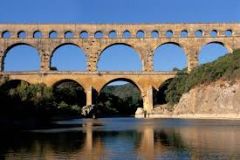
|
ANCIENT ROME: Republican Period Pont Du Gard c. late 1rst century
- Bridge over river - Makes water flow through - Arches |
|
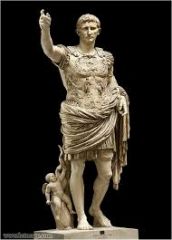
|
ANCIENT ROME: The Early Empire Augustus of Primaporta c. early 1rst century
- Portait of Octavia Augustus (FIRST EMPEROR OF ROME) - a LOT of roman political value - Idealized to look younger/athletic - More "God Like" features - Making statement that he is of divine descent= Venus |
|
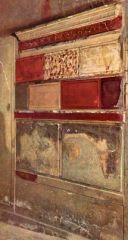
WHAT STYLE PAINTING? |
1rst style Painting- simplistic, just blocks of color |
|

WHAT STYLE OF PAINTING IS THIS? |
2nd Style- more natural life - Feeling of 3D space - Usually will have signs of architecture |
|

WHAT STYLE PAINTING IS THIS? |
3rd style - More about detail - Not to look realistic but moreideal - Illusionistic |
|

|
ANCIENT ROME: The Early Empire Ixion Room c. 60-50 BCE
- 4TH style painting - Incorporates ALL styles |
|
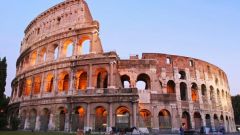
|
ANCIENT ROME: The Early Empire Flavian Amphitheatre (Colosseum) c. 80-70 BCE
- All three orders are used - Romans invented concrete - could hold 50,000 people - had shade |
|
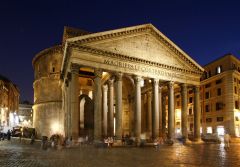
|
ANCIENT ROME: The Early Empire Pantheon c. 118-128 AD
- BIGGEST dome in Ancient Rome - Corynthian columns - "Rotunda" - Has a hole in center of dome |
|
|
Engaged Columns |
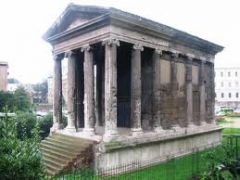
columns in structure |
|
|
Barrel Vault |
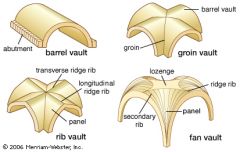
|
|
|
Groin Vault |
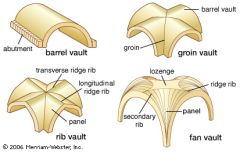
|
|
|
Rotunda |

Building constructed in a circular shape usually topped with a dome. |
|

|
Early Jewish Art Ark of the Covenant and Menorahs c. 3rd century Rome
- inside Jewish Catacomb in Rome - Drawings in underground tunnels - Fresco |
|

|
Early Christian Art Sarcophagus of Junius Bassus c. 359 AD
-2 registars
|
|
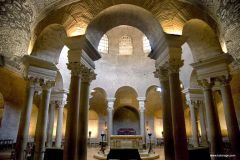
|
Early Christian Art Church of Santa Costanza c. 350 AD
|
|

|
Early Christian Art The Good Shepherd Oratory of Galla Placidia c. 425-426 AD |
|
|
Synagogue |
the building where a Jewish assembly or congregation meets for religious worship and instruction |
|
|
Catacomb |
Underground cemetery for Jewish people |
|
|
Mosaic |
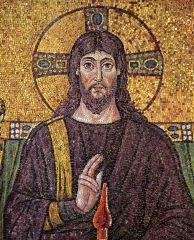
Image formed by arranging small pieces of glass or stone into a surface. |
|
|
Central Plan |
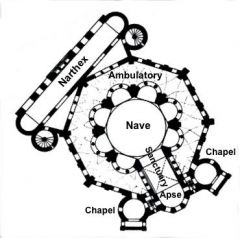
|
|

|
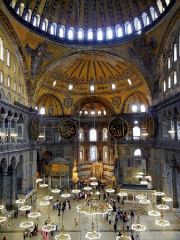
Early Byzantine Art Church of Hagia Sophia c. 532-537 AD
- MASSIVE DOME - not much horizontal emphasis - Made by, Justinian - lacks solidity - gold mosaics |
|

|
Late Byzantine Art Crucifixion c. late 11th century
- Gold background - Mary and John beloved are shown - Skull at bottom of his feet |
|
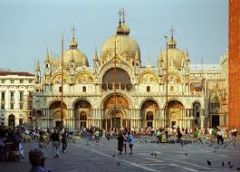
|

Late Byzantine Art Cathedral of St. Mark c. 1063 -gold theme - multi dome - St. Mark was one of the authors of new testament - Many mosaics |
|
|
Penditives vs. Squinches |
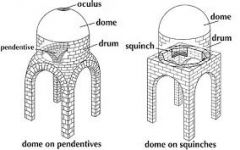
pendentives = round under dome squinches = square under dome |
|

|
Islamic Art Dome of the Rock -actual inside where is said: 1. Muhammed had his revelation 2. Abraham was going to sacrifice his son Ishmael - Octogon shape -Mosaics inside/out - 2 ambulatories |
|
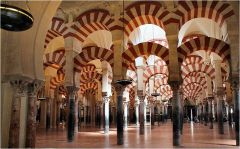
|
Islamic Art Prayer Hall - The Great Mosque c. 786-987 in Cordoba, Spain
-dome right next to the Mihrab -still Minnurat |
|
|
Mihrab |
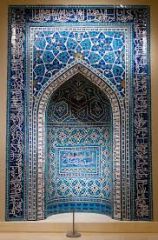
Wall facing Mecca |
|
|
Minbar |
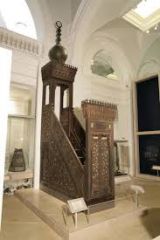
Where leader climbs up to give serman/speech -wooden staircase |
|
|
Qibla |
Mosque wall that faces Mecca |
|
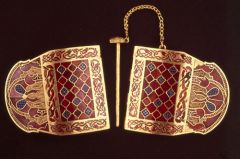
|
"Barbarians" Hinged Clas from Sutton Hoo Burial Ship c. first halfof 7th century
- Intricate designs all over |
|
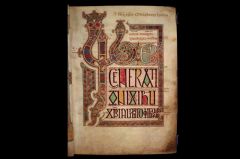
|
Early Christian Art of British Isles Beginning of Matthew's Gospel
- In Lindisfarne Gospel Book - Done on Animal Skin paper |
|
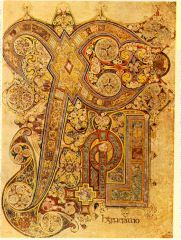
|
Early Christian Art of British Isles Chi Rho Iota Page c. late 8th century
-Book of Kells - completely engulfed in decoration/patterns |
|
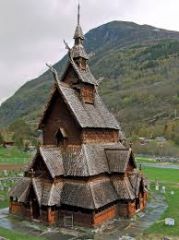
|
Carolingians Stave Church c. 1125-1150 AD
- Borgund, Norway |
|
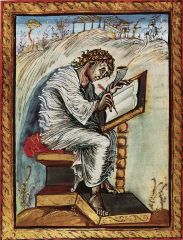
|
Carolingians St. Matthew the Evangelist- Ebbo Gospels c. Second quarter of 9th century
-more line, frantic, anxiety |
|
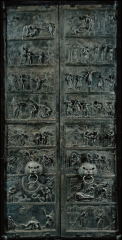
|
Ottonian Art Doors of Bishop Bernward c. 1015
- OLD vs. NEW TESTAMENT |
|
|
Four Evangelists |
Matthew Mark Luke John |
|
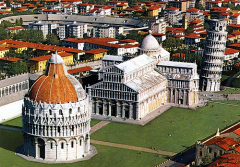
|
Romanesque Cathedral Complex of Pisa c. 1153
- Has baptistry away from church - Church is Basilica style - Corynthian columns |
|
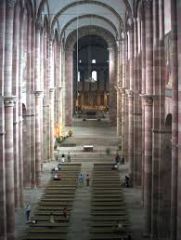
|
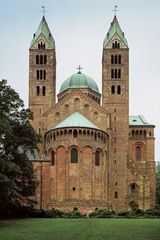
Romanesque Speyer Cathedral c. 1080
-cathedrals getting bigger -VERTICAL EMPHASIS - crossing dome |
|

|
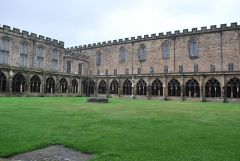
Romanesque Durham Cathedral c. 1087-1133
-England, emphasizes horizontal-ness - Groin Vault - Crucifix floor plan - Courtyard= where Harry Potter filmed |
|
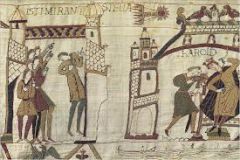
|
Romanesque Bayeux Embroidery- signal the appearance of Halley's Comet c. 1066-1082 |
|
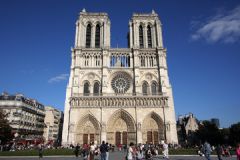
|
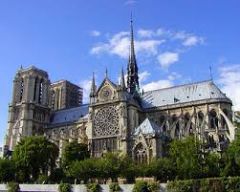
Gothic Art- France Cathedral of Notre-Dame c. 1163
-emphasis on vertical -flying butresses, rose window, twin towers, many arches |
|

|
Gothic Art- France Chartres Cathedral c. 1134
-golden ratio on rose window -taller
|
|
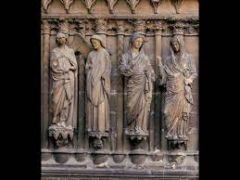
|
Gothic Art- France Central Portal (West Facade) of Reims Cathedral c. 1240
-LEFT TWO: Annunciation (mary/angel) -RIGHT TWO: Visitation (mary/cousin elizabeth) |
|
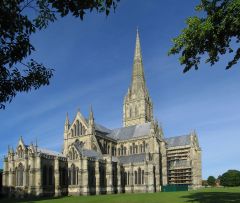
|
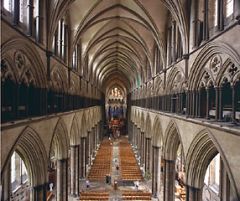
Gothic Art- English Salisbury Cathedral c. 1120-1258
- Focus on not looking up but down |
|
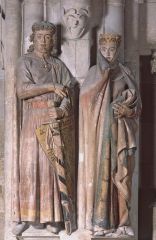
|
Gothic Art- German Ekkehard and Uta c. 1245-260
- AT Naumburg Cathedral - Portrait of the doners - MUCH more realistic than other Gothic Art |
|
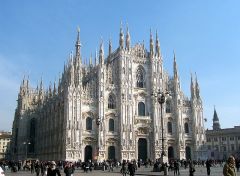
|
Gothic Art- Italian Cathedral of Milan c. 1386
- VERY unique - Used 4 experts when they built it: French, German, English, etc. - Rows of Pinnacles; Flying Buttresses |
|
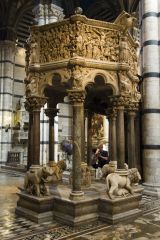
|
Gothic Art- Italian Pulpit c. 1260
- very UNgothic - Hellenistic/High Classical Greek Influence |
|
|
Lancet Window |
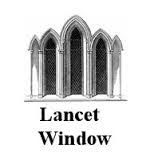
Window that comes to a point at the top |

